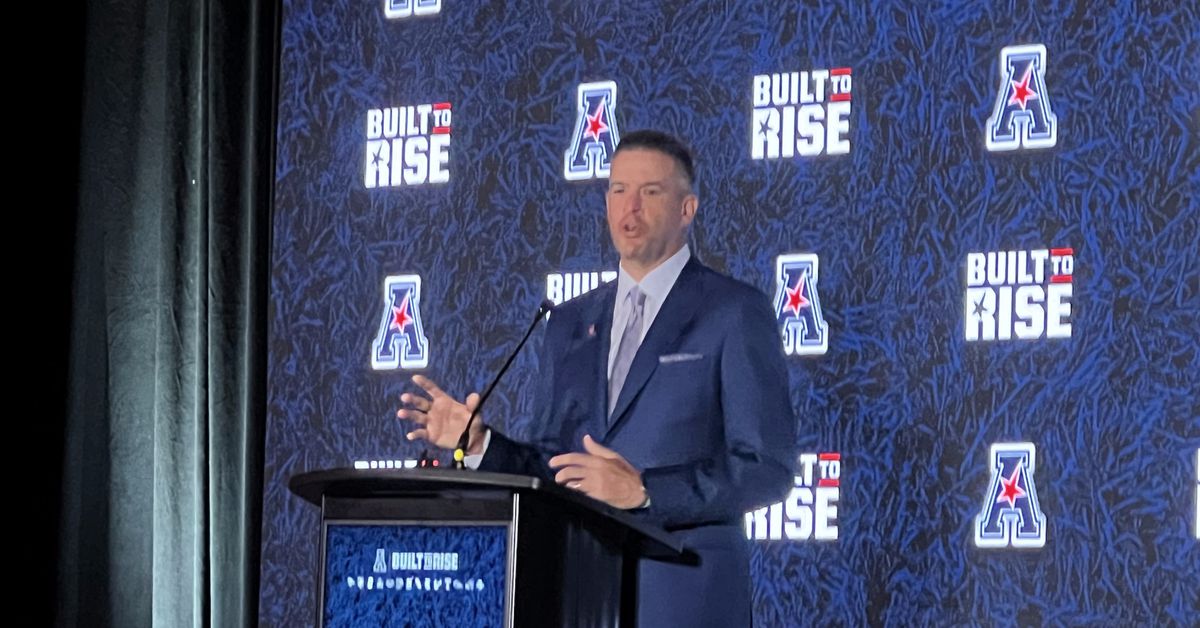The American Conference held its annual media days in Charlotte on Thursday, July 24 and Friday, July 25 — its first conference media days in the Eastern Time Zone since 2019. On Friday, second-year commissioner Tim Pernetti took the stage for nearly 40 minutes, delivering a “state-of-the-conference” address and fielding questions from reporters.
Pernetti spoke at length about his preferred College Football Playoff format, the American’s new branding, unifying media rights across all conferences, fixing the transfer portal, and Memphis’ attempt to buy its way into the Big 12. The commissioner also confirmed the American will begin issuing student-athlete availability reports prior to kickoffs this fall, similar to those the Big Ten and MAC adopted in recent years.
Here are the highlights of Pernetti’s time at the podium in Charlotte:
Out with the AAC, in with the American
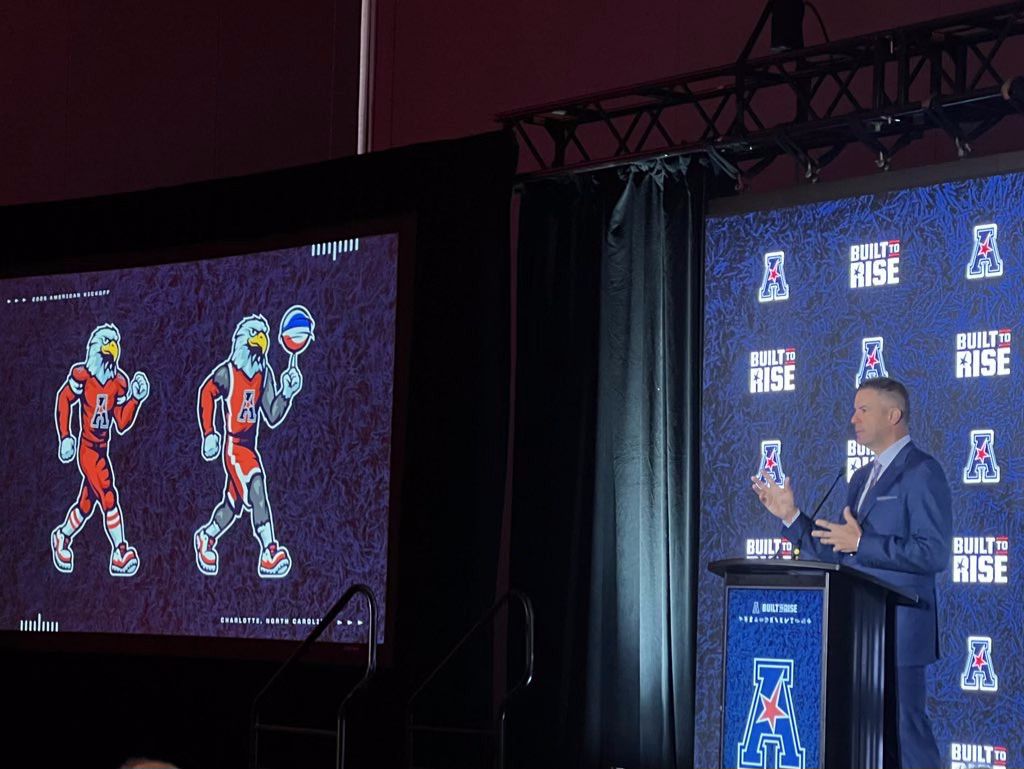
American commissioner Tim Pernetti showcases the league’s new mascot, Soar the Eagle.
Steve Helwick
The American Athletic Conference was established in 2013 from the remnants of the Big East, comprised of a unique mixture of former Big East institutions as well as additions from Conference USA. However, the American Athletic Conference — often referred to as the AAC — is officially no more.
On Monday, July 21, the conference officially rebranded to the “American Conference,” dropping the “Athletic” and the associated “AAC” acronym.
“We’re not trying to be fancy. We’re not trying to be slick. It’s a simplified name — American Conference — a name our fans and the media have been using for years, and we’re gonna proudly own it now,” Pernetti said. “We’ve sunset ‘American Athletic Conference’ and the ‘AAC’ acronym to eliminate confusion, sharpen our voice, and ensure consistent recognition.”
Pernetti discussed how the rebrand took the college football world by storm all week. He cited that the American’s brand modernization spurred 1,600 media stories and mentions, racked up an estimated 3.5 million views, and most notably, generated almost $10 million in earned media advertising value.
“It’s an intentional, strategic evolution of who we are and what differentiates us and creates a pathway to commercial growth, bigger national presence and increasing our competitive position,” Pernetti said.
The rebrand included a new conference tagline, “Built to Rise,” and the unveiling of a mascot Soar the Eagle — which drew plenty of online buzz earlier in the week. The mascot costume remains in the development stages, but the Soar the Eagle is the first official conference-wide mascot in college athletics.
“When we first explored the idea of a mascot symbol for the American, I was skeptical,” Pernetti said. “There were some arguments, there was some knuckle-fighting, there were some screaming matches. We talked about symbols that were uniquely American and nothing measured up to the bald eagle. Soar went from this idea to a commercial asset to a content creator to a community leader. Soar is the first-ever conference brand ambassador. We’re the first conference to pioneer a new model of conference branding that leverages intellectual property.”
Fixing the financials of college athletics
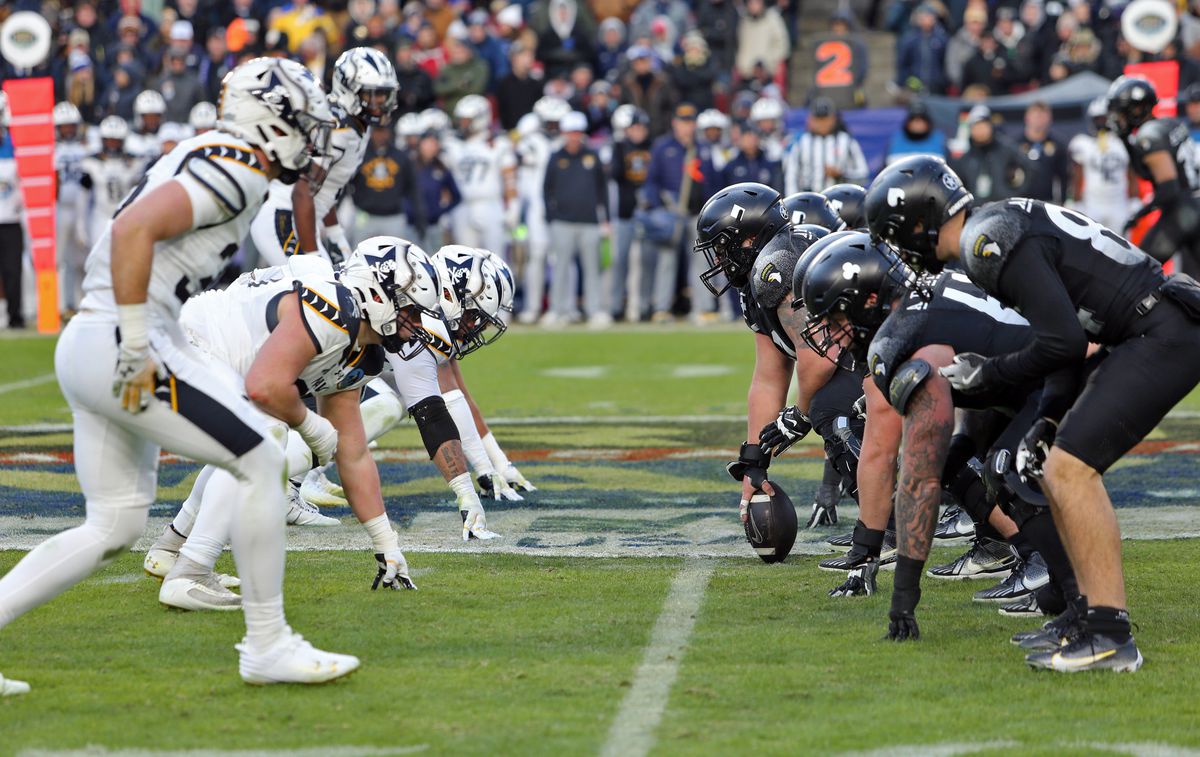
The 2024 Army-Navy Game between two American Conference members drew 9.4 million viewers, the game’s most since 1990.
Danny Wild-Imagn Images
With each passing year, the dollar sign means more and more in college athletics. Conference media deals and NIL have been especially hot topics throughout the last four years, but now with the House v. NCAA settlement, the financials of college athletics become even more complicated.
Colleges can now directly pay student-athletes for the first time ever, and for the 2025-26 academic year, each NCAA institution is capped at $20.5 million in revenue sharing. The American Conference is the first league to implement a spending floor when it comes to revenue sharing, requiring each member institution to distribute $10 million to student-athletes across the next three years.
“The American was the first conference to implement a league-wide minimum investment in member revenue protocol, ensuring our student-athletes across all 15 institutions (Wichita State, which doesn’t sponsor football, is the 15th member) are supported equitably,” Pernetti said. “We also introduced a new performance based revenue distribution model to reward competitive success in football and basketball and reward aggressive non-conference scheduling.”
With revenue sharing on its way, athletic departments are seeking increased revenue to afford payments to student-athletes. Pernetti presented one bold idea to transform revenue — not just for the American Conference, but the FBS as a whole — and that involves a single-unified media rights deal, similar to the media rights deals of the NFL and NBA. There are a slew of legislative hurdles associated with unifying media rights, but Pernetti wants this idea on the table.
“The industry needs revenue, let’s add and get on offense, turning campus-wide challenges into growth opportunities,” Pernetti said. “No single conference or private capital firm can match the upside of collective action. A common-sense solution is to unify media rights across FBS, like the pro leagues, we can dramatically increase total revenue and create a financially sustainable model.”
Pernetti argues that unifying a media rights deal benefits all FBS institutions, lifting the revenue of smallest earners while still compensating the highest earners for their contributions.
“The pie can be so much bigger for all our institutions,” Pernetti said. “In the American, we’re not trying to eat off any other conference’s plate. We believe that the autonomy four (referring to the ACC, Big 12, Big Ten, and SEC) deserve more revenue given the value they bring in television viewership, attendance, sponsorship and more. But I’ve seen the potential upside of consolidation. I’ve seen the numbers, they are backed by data. Revenues can triple.”
Transforming the transfer portal
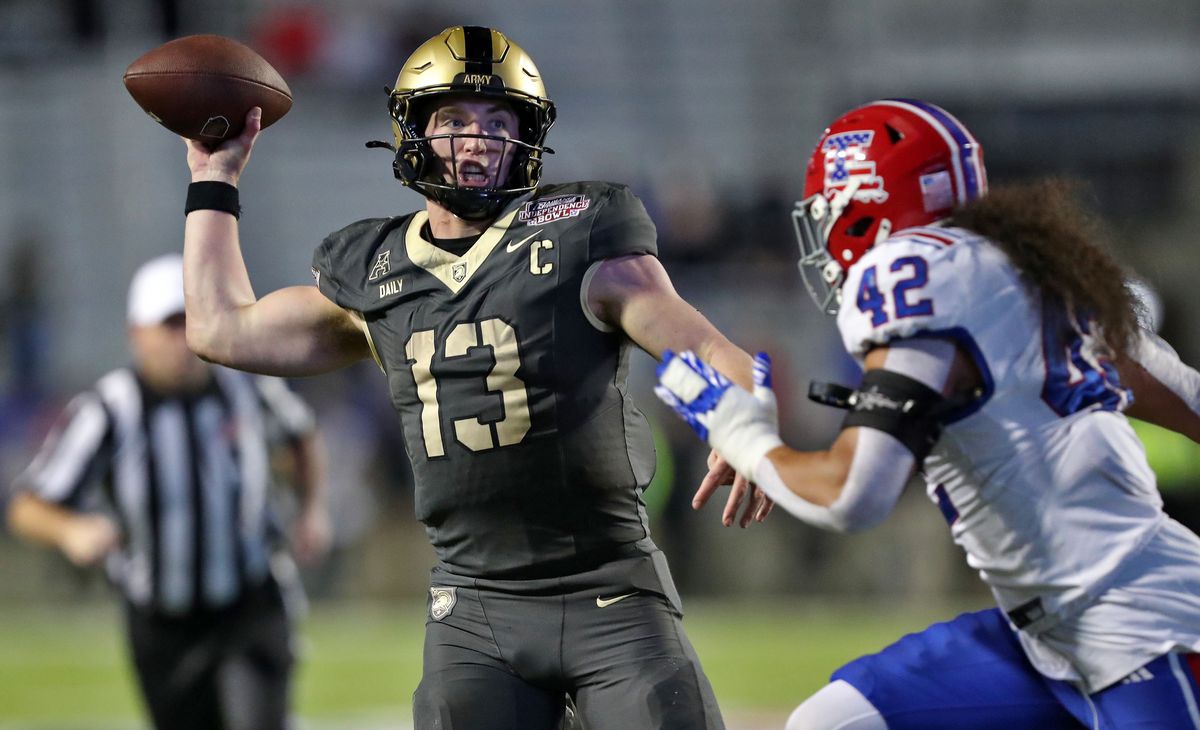
Army faced Louisiana Tech in the 2024 Independence Bowl because Marshall opted out due to a lack of available players.
Danny Wild-Imagn Images
Of the 55 players selected to the All-American Conference First and Second Teams, only nine return to their programs for 2025. Meanwhile, 13 are transferring elsewhere, making the all-conference teams essentially a shopping list for big-money programs in the transfer portal.
The portal works both ways. The American benefits from it, but it also greatly suffers from its existence. It works hand-in-hand with NIL, causing players to frequently leave the conference for more lucrative checks elsewhere. Pernetti spoke against the current transfer portal system, preferring a more stable environment.
“The current structure is a threat to the game, to team culture, to coaches building programs and student-athletes as constant motion de-emphasizes commitment and the true benefits of collegiate athletics,” Pernetti said.
Perhaps there’s no better example of the transfer portal’s shortcomings than the axed 2024 Independence Bowl between Army and Marshall. Sun Belt champion Marshall became the first program to ever opt out of a bowl game due to the portal, as 29 roster members entered the week of Dec. 9 — when the portal first opened. Army was left without an opponent, although 5-7 Louisiana Tech filled the void and ultimately battled the Black Knights in Shreveport.
“Instead of playing another league champion in a bowl game, Marshall reneged on their commitment to play citing an inadequate roster due to the transfers during the December portal window,” Pernetti said. “A transfer portal window between the end of the regular season and bowl games? What the hell are we doing?”
Pernetti’s solution to transfer portal chaos? Revert back to the one-time transfer rule which was in place from April 2021 to April 2024, which allowed undergraduate athletes to transfer once without the penalty of sitting out an entire season. While the previous policy restricted undergraduate transfers, graduate transfers were free to relocate as often as they wanted.
“We need one portal window at the appropriate time of the year,” Pernetti said. “Student-athletes should absolutely have the opportunity to transfer one time freely. Coaches change, family situations change, it’s reasonable. But any transfer beyond that should perhaps require a year in waiting.”
Memphis attempts to join Big 12
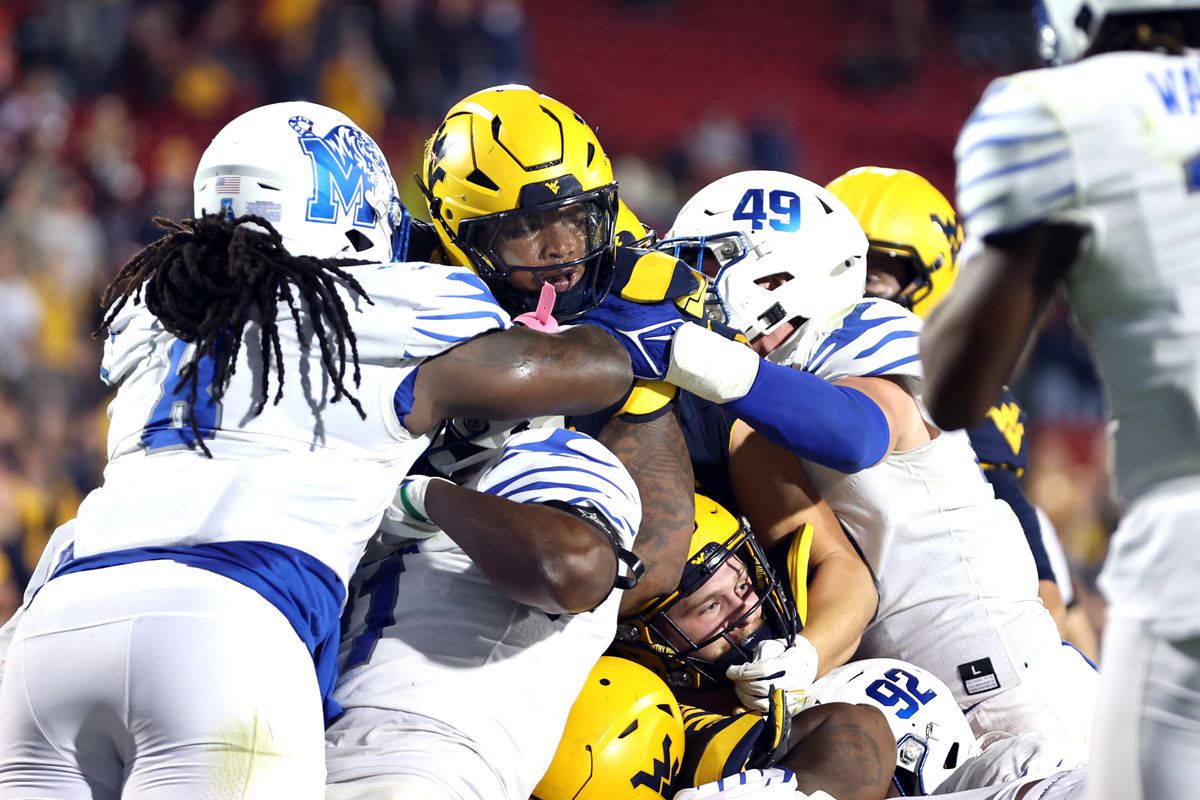
Memphis, fresh off defeating a Big 12 opponent for the second-straight season, attempted to join the Big 12 at a $200 million price tag, but the offer was denied.
Tim Heitman-Imagn Images
Earlier in the week, news broke that Memphis sought to leave the American Conference in favor of the Big 12. Memphis offered roughly $200 million and the forfeiture of some media revenue in order to latch onto a new league. However, the Big 12 did not possess mutual interest, keeping Memphis tied to the American Conference for the time being.
“I was very aware of the conversations,” Pernetti said. “Back when (Memphis athletic director) Ed (Scott) got hired in August, we had very transparent conversations for a year about what’s happening. I understand Memphis’ ambition. I think other schools have that ambition. I admire that ambition.”
Pernetti expressed no ill-will toward Memphis’ desire to leave. In fact, when the current American commissioner served as Rutgers’ athletic director from 2009-13, he negotiated the agreement for Rutgers to leave the American in favor of the Big Ten.
“I was an athletic director years ago when I took Rutgers to the Big Ten,” Pernetti said. “Your job is to do what’s best for your school. I also give them credit for having the guts to go after it. The important thing to remember is this: We’re not surprised by it, and we’re building strong resilient programs in the conference. So when these things happen, they’re not a surprised. I’m very encouraged our membership continues to operate in a transparent manner when these things come around.”

